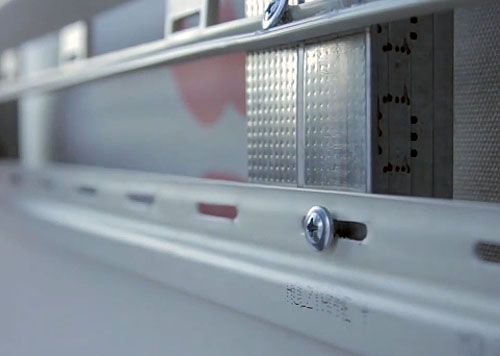Roofing screws
Self-tapping screws with a hexagonal head have a wide range of applications, but most of all they are used for fastening such roofing coverings as metal tiles and corrugated sheets, as well as accessories for them, for which they received the generalized name "roofing".

- The length of self-tapping screws with a hexagonal head is from 19 to 100 mm.
- Shaft diameters 4.8 and 6.3 mm.
They are completed with a washer with a rubber gasket, which is responsible for the tightness of the connection, which is important for the roofing device (so that there is no leakage).
According to the color variety, hats can be of very different colors: red, brown, green, white and others. The color of the cap is matched to the color of the material to be fixed and is marked according to the Ral and RR color standards.
There are also self-tapping screws without painting - just with a galvanized head and a washer.
To fasten (tighten) these self-tapping screws, bits with an internal hexagon are used.
Bit size:
- for self-tapping screws with a rod diameter of 4.8 mm - a bit of 8 mm
- with rod diameter 6.3 mm - bit 10 mm
Confirmat - furniture screw
.
Confirmates are used when assembling furniture.
The most used are 50 mm long with a hex head.
This type of fastener requires mandatory pre-drilling. For this there is a special confirmation drill.
For screwing the confirmations, use hexagons or bits for HEX 4 screwdrivers.
Construction wood grouses
Capercaillie is a thick-rod self-tapping screw with a hex head.
Capercaillies are widely used in fastening various units of heavy structures, where special strength and reliability of the connection is required.
In the construction of pitched roofs, wood grouses are used for wooden truss systems and interfloor floors.
- The thickness of the rod for the wood grouse is from 6 to 10 mm.
- The size of the hex head for wood grouses is from 10 to 19 mm.
They are tightened by hand with wrenches of the appropriate size, or with attachments using ratchets or an electric tool. Pre-drilling may be necessary.
For fastening to bases made of concrete, foam block bricks, etc. - they are used together with a plastic dowel.

What are they?
There are few types of self-tapping seeds. First of all, they differ in design features.
- Tip shape. "Bedbugs" can have either a sharp end or a drill. Self-tapping screws with a drill are designed for fastening metal with a thickness of 2 mm, and sharp screws - for sheets no more than 1 mm.
- Head shape. All self-tapping screws for GCR have a semi-cylindrical head with a fairly wide base. This allows you to increase the clamping area of the two parts to be joined, as well as to close the fastening point.
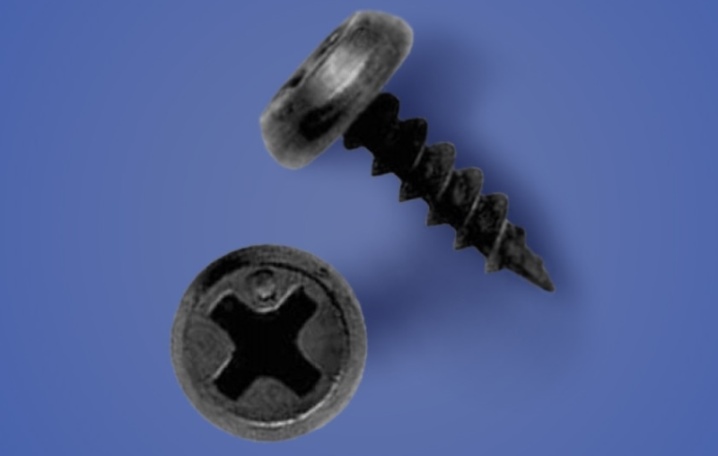
Self-tapping bugs are made of low-carbon, durable steel. However, in order to give these hardware increased anti-corrosion properties and thereby increase their service life, the products are covered with a special protective layer. It comes in 2 types.
- Phosphate layer. Self-tapping screws with such a top layer are black. Due to this protective layer, the adhesion of the paint coating to the hardware is improved, which means that for painting "seeds" with a phosphate layer is the best choice. Very often, after installation, such self-tapping screws are covered with a layer of bitumen varnish, which enhances the characteristics of the protective layer in high humidity conditions.
- Galvanized layer. "Bugs" with this type of protective coating have a silvery color, an attractive appearance and can even be used on decorative surfaces as a unique design element.
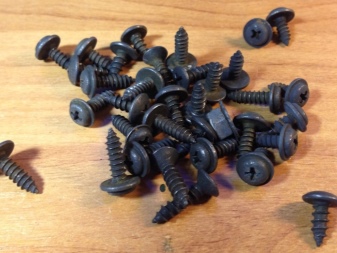
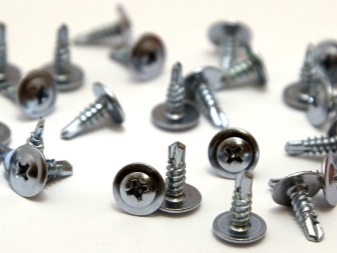
Also, self-tapping seeds have various sizes and are of several types:
- 3.5x11 - galvanized with a sharp end;
- 3.5x11 - galvanized with a drill end;
- 3.5x9 - sharp galvanized;
- 3.5x9 - galvanized with a drill;
- 3.5x11 - phosphated with a sharp end;
- 3.5x11 - phosphated with a drill;
- 3.5x9 - phosphated sharp;
- 3.5x9 - phosphated with a drill.
The dimensions and outer coating of the self-tapping screw are selected based on the operating conditions of the structure, its dimensions, and the materials used.

Description and purpose
Self-tapping screws are so-called self-tapping screws. The main feature of such products is that there is no need to make a hole for their installation in advance. These hardware themselves, in the process of screwing in, due to the special shape and grooves, make themselves the desired groove size.
The thread of any self-tapping screw has a triangular shape with sharp edges. Structurally, this hardware is a close relative of the screw, but the latter has less pronounced and sharp edges of the thread. Self-tapping screws are used for mounting and fixing a wide variety of materials: wood, metal and even plastic. This variety allows you to simplify work and achieve a high installation speed. For drywall, there are also fasteners - "seeds".

Self-tapping seeds differ from all their "brothers" primarily in their small size. But they also have their own design features. The head of the self-tapping bug has a wide and flat shape, from the edge of which there is a special roller that presses the part it fixes. Most often, this type of fastener is made from galvanized steel or from conventional steel using phosphating.
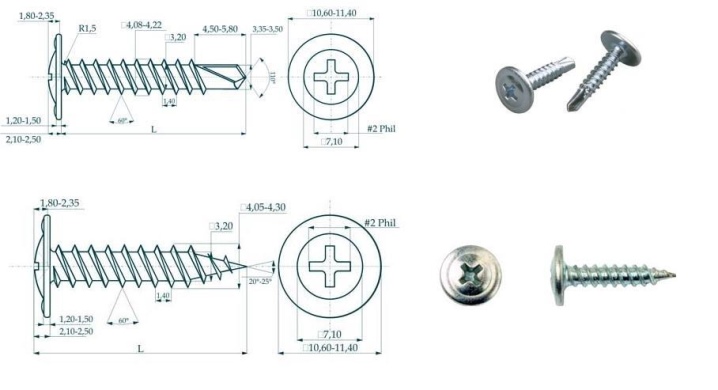
The variety of self-tapping seeds also includes products with a press jaw. The diameter of such hardware is 4.2 mm, and the length can be very diverse. For plasterboard structures, a length of up to 11 mm is used. Self-tapping screws with a press washer are reinforced types of fastening. This means that the taller trapezoidal head makes the slot deeper, which means the fastening is more reliable.
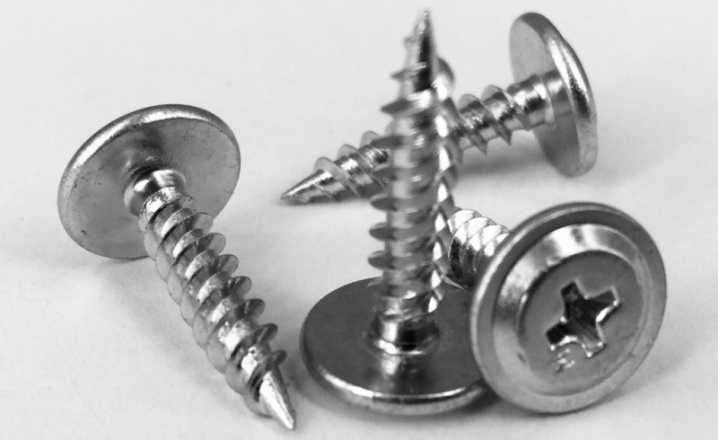
Depending on what material will be placed on the plasterboard structures - wood, plastic or metal, you can choose the most suitable hardware.
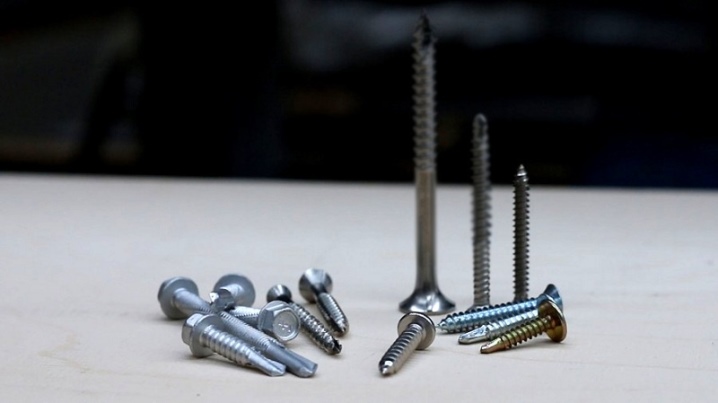
Usage Tips
In order to work correctly with self-tapping seeds, you should adhere to the following practical recommendations.
It is very convenient to screw the screws into the gypsum board with a reverse screwdriver. The hardware is mounted using a special bit (Ph2), which controls the drilling depth. Thus, the head of the self-tapping screw screwed up to the stop is flush with the surface of the drywall. A good screwdriver and a suitable attachment are the key to quick and high-quality installation.

Fasteners "butterfly" are used in the work with gypsum board in cases where you want to attach something heavy enough to drywall. The device looks like a special plastic dowel with a self-tapping screw. To install it, you must first drill a hole in the sheet. When twisting the hardware, the internal mechanism folds and is very tightly pressed against the back wall of the drywall. There are several fundamental technical points:
- the hole for the "butterfly" is drilled with a diameter equal to the diameter of the dowel, and its depth should be 5 mm more than the size of the self-tapping screw;
- then the hole is cleaned of dust (using a construction vacuum cleaner), and the mount can be mounted.

"Butterfly" is able to withstand a load of 25 kilograms.
In order for the fastening of the gypsum board to the profile to be reliable and of high quality, the required number of "seeds" should be taken into account. So, if the frame is made of wood, then the step of installing the hardware is 35 centimeters, and if it is made of metal, then from 30 to 60 centimeters.
A variety of fasteners allows you to choose high-quality hardware for any type of work. When working with drywall, reliability and installation speed are important, which is why self-tapping seeds are so in demand.With their help, all work with GCR goes many times faster, and the result is always pleasing.
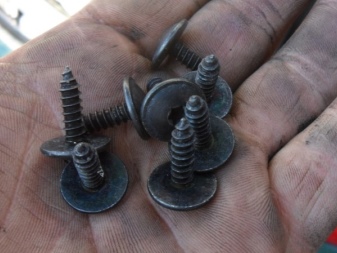

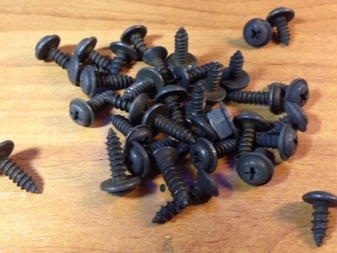
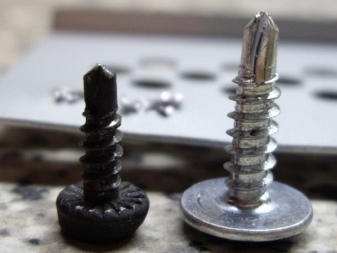
For how the bedbugs self-tapping screws look, see the next video.
How to choose the "right" self-tapping screw
It is not enough to decide on the type of self-tapping screw that is necessary for a certain type of work, it is also necessary, among the many options, to choose really high-quality, durable fasteners that will not fail at the most crucial moment. Just take a close look at the screw. It must meet these simple criteria: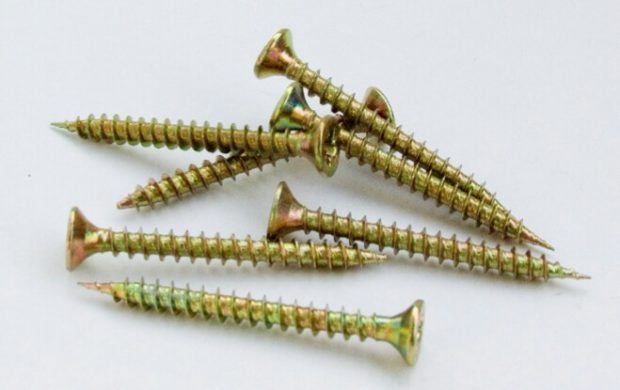
- Same color scheme. All screws of the same batch must be of the same color and shade, if we are talking about black or yellow screws. If all products are kept in the same color, this may indicate that the entire batch has undergone the same type of processing under the same conditions and has the same strength and corrosion resistance.
- The dimensions of the screws of the same batch should not visually differ from each other.
- The pitch between the threads must be the same.
- If these are self-tapping screws with a drill at the end, then it should not have burrs at the edges, the sharp end of the self-tapping screw should be free of burrs and not be broken off.
- The hole, in the form of which the slot is made, must be clear, symmetrical and sufficiently deep.
- High-quality self-tapping screws are usually marked with a capital Latin letter. This speaks of factory production, and for you it's like a little tip in case you have to buy missing fasteners.
If you see that the screws you have chosen meet the above criteria, then you can be sure that you are holding really high-quality fasteners in your hands that will not break during the installation process.
How to choose wood screws
It is not worth using self-tapping screws for metal or universal screws for fixing wood. Universal ones are good when you need to twist wood and metal. And when twisting two pieces of wood, they work worse. In the sense that specialized fasteners will hold the wood better. That is, we consider only wood screws. Believe me, there will be plenty to choose from.
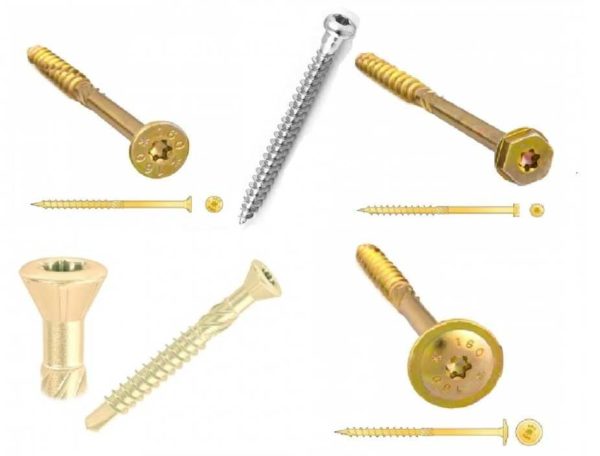
Wood screws are better than yellow (yes, expensive) or white (a little cheaper)
As already said, wood screws have a rarer thread with a higher profile (the grooves between the turns are deeper). They are used not only for wood, but also for all types of sheet materials: gypsum fiber board, plywood, OSB (OSB), fiberboard and chipboard. Now about which ones work better.
Thread and other "bells and whistles"
First you need to choose the type of hat. Secret or with a press washer, cylindrical, hemispherical - select based on what kind of connection you need to make. It is also recommended to choose a spline of the TORX type, since it best transfers the torque from the power tool. Further in order.
-
It is necessary to determine whether the thread should be applied to the entire rod or not. If you need to fasten two pieces of wood and pull them tightly together, take a self-tapping screw with an incomplete thread. This means that there must be an unthreaded area under the head. The length is equal to the thickness of the attached part or slightly more. Due to this zone, one part is "attracted" to another.
- To make it easier to screw into hard rock or sheet material, there are wood screws with a router or mill. The cutter is available only on self-tapping screws with an incomplete thread. It looks like a few screw-type notches, which are applied before the start of the thread. The notches soften the wood, after which the self-tapping screw "goes" better.
- In general, wood screws have a thinner point and thus prevent wood cracking. But there are also special "lotions" against cracking. It can be:
- grooves;
- cutting edges in the form of notches on the screw body;
- notches on several lower threads.
Are these bells and whistles necessary or is it wasted money? Incomplete threads are nothing new. One detail "sits" on top of another much more densely. And try the rest.Only from your own experience you will understand whether it works or not, and what exactly suits you best.
And practical advice on choosing wood screws
It is important that the thread runs straight from the tip itself. If the first turn is too far or the tip is blunt, do not take
There will be continuous torment, not work.
How to screw a self-tapping screw into thick metal?
Any roofing screw or galvanized with a press washer is quite possible to screw into thick metal, even if
the hardware is not supplied with a drill. To do this, you just need to pre-drill the base. This method can
tighten screws even in metal, thicker than 5 mm.
The main principle in such operations is that the diameter of the drill should differ from the diameter of the self-tapping screw by only a few
tenths of a millimeter. The thicker the base and the harder the metal, the smaller the difference. For example: for twisting
galvanized products 4.2 mm. into metal 2 mm. You will need a 3.5 - 3.8 mm drill, and 5 mm for screwing into metal.
you will need a 4.0 mm drill. To achieve this goal, it is worth purchasing several drills, with a step of 0.1 mm., Up to
to the declared diameter of the self-tapping screw.
Before screwing into a responsible place, it is better to drill a test hole and try to tighten the screw. After all
if the diameter is poorly matched, the cap will break off easily and it will be difficult to remove the stuck tip.
Rate the publication:
- Currently 4.67
Rating: 4.7 (9 votes)
Drilling holes for self-tapping screws
There are often cases when, before fastening to a self-tapping screw, it is necessary to drill the materials to be fastened (go through the attachment point with a drill). This should be done for thick and thin materials. For example, if you try to screw a self-tapping screw into dense oak wood without preliminary drilling, the self-tapping screw will simply break off, bend or significantly under-screw to the end, and the connection density will be absent (a gap will appear between the connected elements).
When attaching thin parts, pre-drilling is necessary in order to avoid cracks and splits in the thin attached material.
You can select the diameter of the required drill for drilling under one or another self-tapping screw according to this table:
| Self-tapping screw diameter | Drill diameter |
|---|---|
| 4.0 mm | 2.5-3.0mm |
| 4.5 mm | 3.0-3.5mm |
| 5.0 mm | 3.5-4.0mm |
| 6.0 mm | 4.5 mm |
If the diameters of the drill and the self-tapping screw are equal, the adhesion density will be very low or there will be none at all.
Tighten the black self-tapping screws using a PH2 screwdriver or similar bat. For golden screws - PZ bit No. 1, No. 2 or No. 3, depending on the diameter of the self-tapping screw.
The principle of fastening siding panels
Installation of siding panels is carried out on a frame fixed to the wall. The lathing for the installation of siding can be made from a wooden bar or a metal profile. It is better to mount metal siding on metal profiles, given its greater weight than vinyl siding. For panel mounting, oval-shaped holes are made along the edge of the upper side of the panel. They are located quite often, so it is not difficult to combine the mounting hole and the rack of the batten.
Below the perforation there is a side curved downwards. The next panel is hooked onto this ledge with a special groove, the size of which corresponds to the ledge. Which is also attached from above through perforations. The panels are mounted from the bottom up. All additional elements also have the same perforation for fastening. The photo shows a schematic representation of the principle of siding installation.
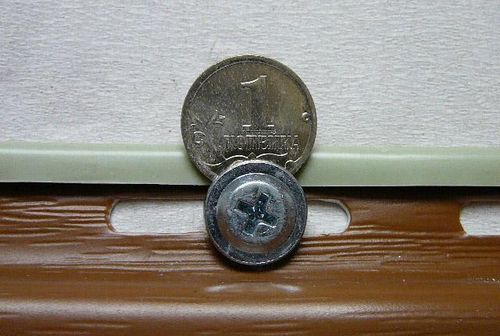
Self-tapping screw with a hex head ("Hexagon self-tapping screw")
It looks like an ordinary bolt, but differs in the following features:
- infrequent screw thread;
- slightly pointed end.
The main application is fixing massive parts and large objects."Hexagonal self-tapping screw" can be screwed into wood, and if you use a dowel, then into concrete.
Attention! The dowels for hexagonal screws must be two sizes larger than the self-tapping screw!
All work with such fasteners is carried out with keys of 17, 13 and 10 mm. It is clear that the head of the long and thickened screw will be 17.0 mm in size, and at the shortest 10.0 mm.
The benefits of siding
There are many reasons for the popularity of siding. The price of siding panels perfectly competes with the cost of other materials for facades: lining made of natural wood, planken - wood or composite materials, blockhouse, porcelain stoneware, alucobond panels, natural stone. The second reason is ease of installation. Anyone who held a tool in their hands can decorate the facade of their own house. All work consists in mechanical fastening of standardized parts to the frame.
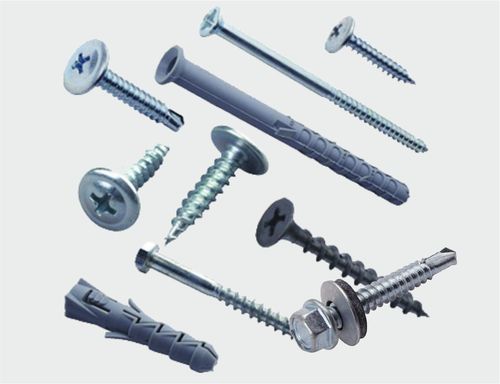
Choosing self-tapping screws
A rich assortment of additional details - window frames, internal and external corners, docking strips, allow the installation of panels with the device of decorative architectural decoration of the facade without any production of additional elements. The absence of parts requiring gluing and painting means that the siding can be installed in all weather conditions. The unified, well-thought-out elements of the facade finish allow for a complete installation in a short time.
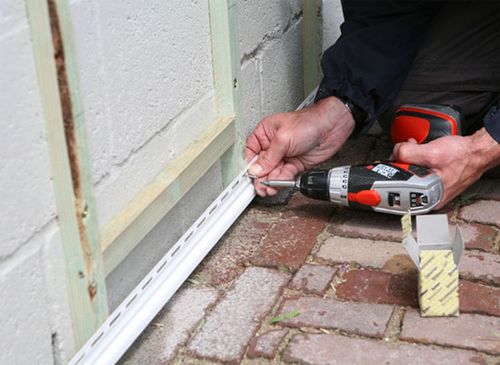
The mechanical method of fastening involves the use of fasteners. Below we will consider how to install panels so that the facade finish will last for more than one year and please the owner with its appearance.
